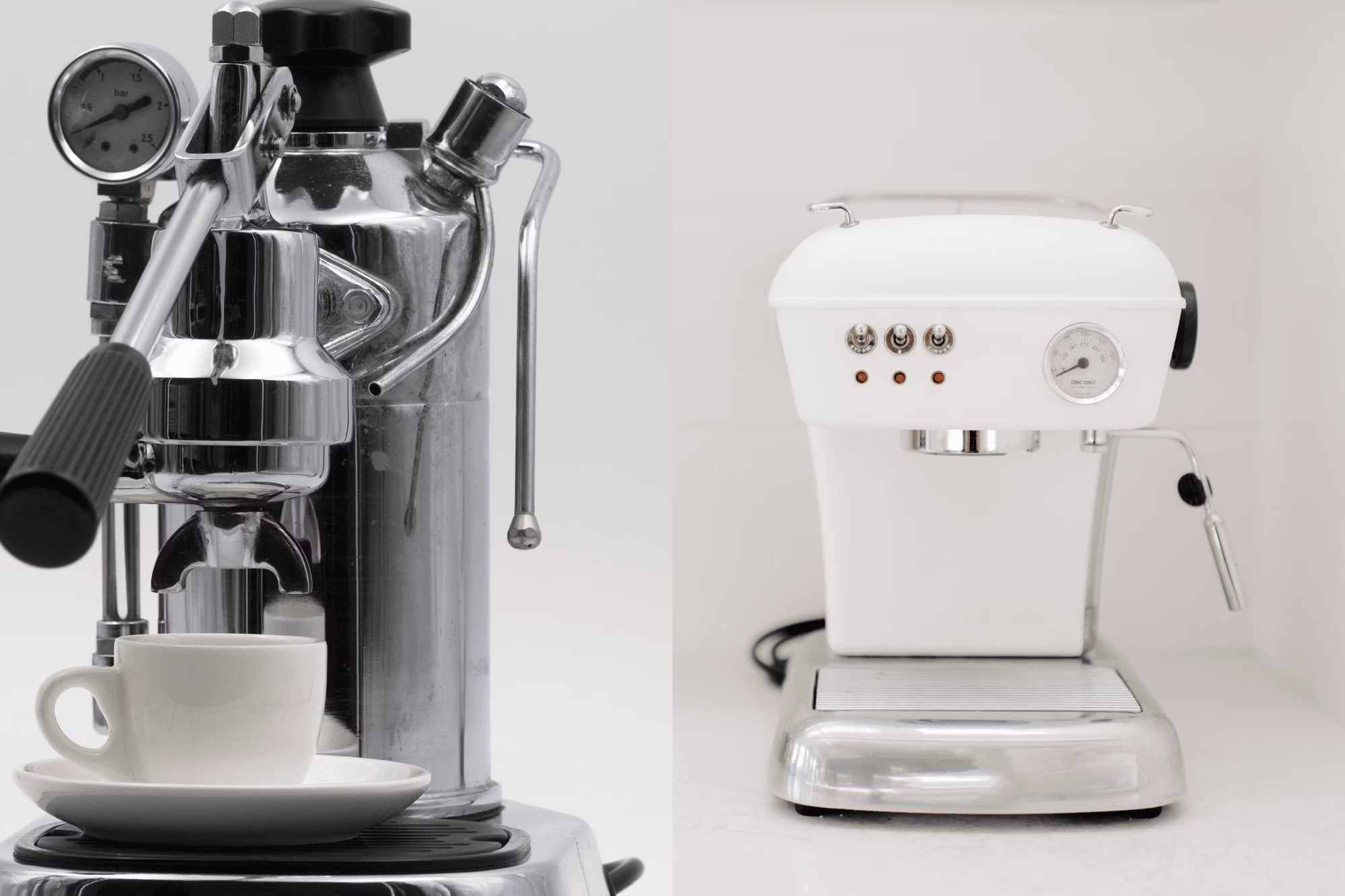Are you tired of spending $5 every morning at your local coffee shop, but intimidated by the world of home espresso? You’re not alone. Many coffee lovers dream of creating café-quality drinks at home but worry about the learning curve and cost of entry. The good news? Becoming your own barista is more accessible than ever.
The journey to espresso excellence doesn’t require breaking the bank or earning a barista certification. Today’s market offers an impressive array of budget-friendly machines that balance affordability with functionality, designed specifically with beginners in mind. These entry-level espresso makers come equipped with user-friendly features that help newcomers navigate the once-intimidating process of extraction, milk steaming, and latte art.
In this comprehensive guide, we’ll walk through five exceptional espresso machines that deliver impressive results without the premium price tag. Whether you’re looking to cut down on coffee shop expenses, impress weekend guests with homemade cappuccinos, or simply enjoy the therapeutic ritual of crafting your perfect morning brew, these machines provide the perfect starting point for your home barista adventure. Let’s explore how these affordable options can transform your kitchen into your new favorite coffee destination.

Let’s dive into the world of accessible espresso and find your perfect match!
Table of Contents
![Insert image of an inviting home espresso setup with a beginner-friendly machine]
What Makes a Good Beginner Espresso Machine?
Before we jump into our top picks, let’s quickly cover what you should look for in your first espresso machine. Trust me, this will save you from buyer’s remorse (and some truly undrinkable coffee).
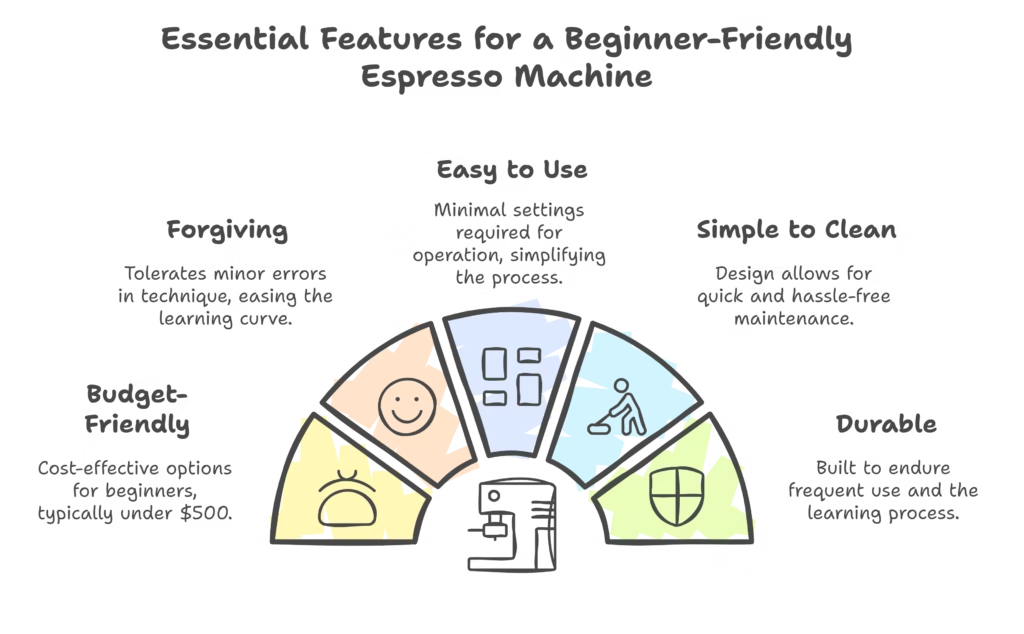
The sweet spot? A machine that balances affordability with enough quality features to produce a decent espresso. After all, what’s the point of saving money if your coffee tastes like bitter dishwater?
Now, let’s get to the good stuff our top 5 picks that check all these boxes and more.
Top 5 Affordable Espresso Machines for Beginners
1. Breville Bambino Plus
Price Range: $499
Let me start with a confession: I’m slightly biased toward the Bambino Plus because it’s what saved my home coffee game. This compact powerhouse has changed how I start my mornings.
The Breville Bambino Plus strikes that perfect balance between simplicity and capability that beginners dream of. With its automatic milk texturing system, you can achieve barista-quality microfoam without the years of practice. Just set your preferred milk temperature and texture level, and the machine does the rest.
What makes this machine especially beginner-friendly is its thermojet heating system. You know that painful wait for machines to heat up? Gone. The Bambino Plus reaches optimal extraction temperature in a mere 3 seconds. That’s faster than I can decide which mug to use!
The pre-infusion function is another standout feature. It gently soaks the coffee grounds before extraction, ensuring even saturation and a more balanced espresso essentially compensating for minor tamping errors that beginners often make.
Pros:
- Lightning-fast heat-up time
- Automatic milk frothing with adjustable settings
- Compact footprint (great for small kitchens)
- Pre-infusion feature forgives minor technique flaws
- Simple, intuitive controls
Cons:
- At the upper end of “affordable” for beginners
- Doesn’t include a built-in grinder
- Some users find the water tank slightly small
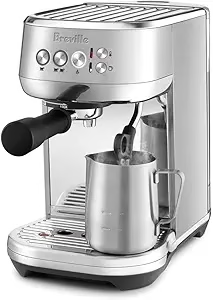
Perfect for: The aspiring home barista who wants quality results without a steep learning curve and values counter space.
2. De’Longhi Stilosa
Price Range: $99-$120
If the Breville made you wince at its price tag, let me introduce you to the De’Longhi Stilosa proof that good espresso doesn’t require triple digits. This little machine is what I recommend to friends who ask, “What’s the absolute cheapest way to make real espresso at home?”
The Stilosa is refreshingly straightforward. No digital displays, no complex programming just a simple dial and a manual milk frother. This back-to-basics approach actually helps beginners understand the fundamentals of espresso making without getting lost in features.
Despite its budget price, the Stilosa includes a 15-bar professional pressure pump system—the same pressure level found in much pricier machines. This ensures proper extraction of those rich coffee oils and aromas that make espresso, well, espresso.
I particularly appreciate the stainless steel boiler, which provides better temperature stability than you’d expect at this price point. The manual milk frother takes practice but gives you direct control over your milk texture—consider it training wheels for more advanced machines later.
Pros:
- Exceptionally affordable entry point
- Simple, intuitive operation
- Compact and lightweight design
- Surprisingly durable construction
- Compatible with both ground coffee and ESE pods
Cons:
- Manual milk frothing requires practice
- No pre-infusion feature
- Plastic tamper included is basic (you’ll want to upgrade)
- Limited customization options
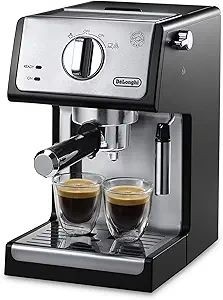
Perfect for: The budget-conscious beginner who wants to learn espresso basics without a significant investment.
3. Gaggia Classic Pro
Price Range: $449
The Gaggia Classic Pro is what I call the “grow with you” machine. It’s like that reliable friend who’s there for your awkward beginner phase but sticks around as you develop your skills.
This Italian-made machine has been a staple in the entry-level espresso world for decades, and for good reason. Its commercial-style 58mm portafilter the same size used in café machines introduces beginners to professional standards from day one.
What impressed me about the Gaggia is its commercial steam wand. Unlike “panarello” wands (those plastic attachments that automatically froth milk), this wand gives you full manual control. Yes, there’s a learning curve, but mastering this skill early pays off in your coffee journey.
The machine’s build quality is where it really shines. With a brushed stainless steel housing and brass components, the Classic Pro is built to last years—perhaps even decades with proper maintenance. It’s the kind of machine you’ll keep even after you’ve “graduated” to more advanced models.
Pros:
- Professional 58mm portafilter prepares you for commercial standards
- Exceptional build quality with commercial components
- Commercial steam wand for true milk texturing
- Simple three-switch operation keeps things uncomplicated
- Renowned repairability and longevity
Cons:
- Steeper learning curve for milk frothing
- No PID temperature control (temperature can fluctuate)
- Limited “hand-holding” features for complete beginners
- Requires a quality grinder for best results
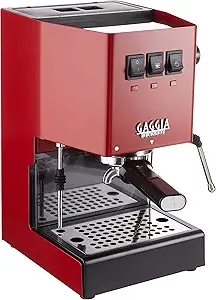
Perfect for: The committed beginner who wants room to grow their skills with a machine that will last for years.
4. Flair Neo
Price Range: $165-$190
Now for something completely different! The Flair Neo isn’t your typical espresso machine it’s a manual lever press with no electricity required. Before you scroll past thinking “that’s too complicated,” hear me out.
I was skeptical too, until a barista friend insisted I try his. The Neo is Flair’s most beginner-friendly model, featuring a pressurized portafilter that helps compensate for grind size and tamping inconsistencies—common issues when you’re starting out.
What makes the Neo special is how it connects you to the espresso-making process. You physically press the water through the coffee, feeling the resistance and controlling the pressure. This hands-on approach taught me more about extraction in a week than months with an automatic machine.
The portability factor is unbeatable. I’ve taken mine camping and to hotel rooms, pulling shots that put room service coffee to shame. And since there are no electronics or boilers to fail, it’s practically indestructible.
Pros:
- Affordable entry to true manual espresso
- Pressurized portafilter forgives grind and tamp errors
- No electricity needed—perfect for travel or small spaces
- Incredible durability with minimal maintenance
- Clear brewing chamber lets you watch extraction happen
- Can be upgraded as skills improve
Cons:
- Requires separate solution for heating water
- No built-in milk frothing capability
- Takes longer to prepare than automatic machines
- Steeper learning curve for consistent results
- Not ideal for making multiple drinks quickly
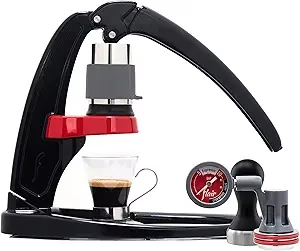
Perfect for: The hands-on learner who appreciates the craft of espresso and wants deep understanding of the extraction process.
5. Nespresso Vertuo Next with Aeroccino
Price Range: $179-$220
“Wait, a capsule machine on an espresso enthusiast list?” I hear the purists gasping. But let’s be realistic—sometimes the best beginner machine is the one you’ll actually use consistently.
The Nespresso Vertuo Next offers something unique: foolproof consistency. Each capsule contains precisely ground coffee, and the machine’s barcode reading system automatically adjusts brewing parameters for each capsule type. For absolute beginners intimidated by variables like grind size, dosing, and tamping, this removes all guesswork.
When paired with the Aeroccino milk frother, you can create surprisingly decent cappuccinos and lattes with zero learning curve. I keep one in my office for those hectic workdays when I need good coffee without the ceremony.
What impressed me most was the crema thanks to Nespresso’s Centrifusion technology, even capsule coffee produces that rich, golden layer on top that’s characteristic of proper espresso.
Pros:
- Absolute consistency with zero technique required
- Super-fast operation (under 30 seconds for espresso)
- Clean, minimal design that looks premium
- Wide variety of capsule flavors and intensities
- Virtually no maintenance beyond emptying capsules
- Aeroccino produces decent milk foam with one button
Cons:
- Ongoing cost of proprietary capsules
- Not “true” espresso by purist standards
- Limited customization of extraction
- Environmental impact of capsules (despite recycling program)
- No learning pathway to improve barista skills
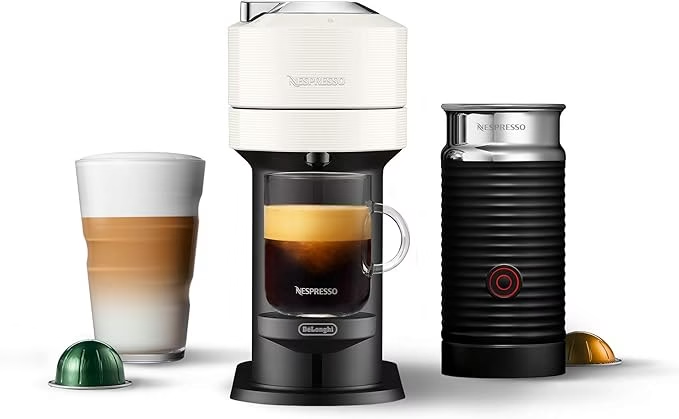
Perfect for: The convenience-focused beginner who wants consistent results with minimal effort and learning.
Comparison Table: Top 5 Affordable Espresso Machines for Beginners
| Breville Bambino Plus | $499 | Semi-automatic | Automatic | 4 | 4 | Those wanting quality results with minimal learning |
| De’Longhi Stilosa | $99-$120 | Semi-automatic | Manual frother | 3 | 3 | Budgetconscious beginners |
| Gaggia Classic Pro | $449 | Semi-automatic | Commercial wand | 2 | 5 | Long-term investment, skill development |
| Flair Neo | $165-$190 | Manual lever | None (separate purchase) | 2 | 5 | Hands-on learners, travelers |
| Nespresso Vertuo Next | $179-$220 | Capsule | Aeroccino (included) | 5 | 1 | Convenience-focused beginners |
The Beginner’s Guide to Choosing Your First Espresso Machine
Now that we’ve explored the top contenders, let’s address some common questions that might help you narrow down your choice.
What Should I Look For in an Espresso Machine for Beginners?
When shopping for your first espresso machine, prioritize these features:
Pressure System: Look for at least 9 bars of pressure, which is the minimum needed for proper espresso extraction. Many machines advertise 15+ bars, but anything above 9 is primarily marketing the machine will regulate down to 9 bars during brewing.
Heating System: Thermoblock or thermocoil systems heat quickly and are ideal for beginners who might not plan ahead. Traditional boilers take longer to heat but often provide more stable temperatures.
Portafilter Type: Pressurized portafilters (sometimes called “dual-wall”) are more forgiving for beginners and less dependent on perfect grind size. Non-pressurized portafilters require more precision but produce better results as your skills improve.
Milk Frothing Options: If lattes and cappuccinos are your drinks of choice, consider whether you want automatic frothing (easier but less control) or manual (steeper learning curve but more customization).
Size and Footprint: Be realistic about your counter space. Even the most feature-packed machine won’t get used if it’s constantly being stored away because it’s too bulky.
Build Quality: Look for metal components where possible, especially for the boiler and group head. Plastic parts are more prone to breaking and don’t retain heat as effectively.
What is the Difference Between Automatic, Semi-Automatic, and Manual Espresso Machines?
This is one of the most confusing aspects for beginners, so let’s break it down simply:
Fully Automatic Machines: These handle everything from grinding beans to extracting espresso to frothing milk with the press of a button. Super-automatic machines even clean themselves. They’re incredibly convenient but offer limited learning opportunities and typically cost much more than our affordable recommendations.
Semi-Automatic Machines: These are the sweet spot for most beginners. You’ll grind the beans, tamp the coffee, and start/stop the extraction, but the machine maintains the pressure and temperature. Most of our recommendations (except the Flair and Nespresso) fall into this category.
Manual/Lever Machines: Like the Flair Neo, these require you to physically create the pressure for extraction by pulling a lever. They offer the most control and connection to the process but require more skill and consistency.
Capsule/Pod Systems: These use pre-packaged coffee capsules and fully automated brewing. They’re the simplest to use but offer the least customization and typically don’t produce true espresso (with Nespresso being a notable exception that comes close).
How Much Should I Spend on a Beginner-Friendly Espresso Machine?
This is where I’ll be brutally honest: while you can find espresso machines for under $100, most of these make significant compromises in build quality and extraction capability.
For a machine that will produce genuinely enjoyable espresso and last through your learning phase:
- Budget option: $100-$200 (De’Longhi Stilosa, Flair Neo)
- Mid-range option: $200-$350 (Many not on our top 5 list fall here)
- Investment option: $350-$500 (Breville Bambino Plus, Gaggia Classic Pro)
Remember that the machine is only part of the equation. You’ll also need:
- A decent grinder ($100-$250 for beginner-friendly models)
- Fresh beans ($15-$20 per pound)
- Accessories like a tamper, milk pitcher, and scale ($50-$100 total)
If your total budget is tight, consider starting with something like the Flair Neo or Nespresso system, which can work with pre-ground coffee or capsules, eliminating the immediate need for a quality grinder.
Do I Need a Separate Grinder for My Espresso Machine?
I won’t sugarcoat this: a good grinder is just as important as the espresso machine itself sometimes more so. Here’s why:
The grind size directly affects extraction rate. Too fine, and your espresso will be bitter and over-extracted. Too coarse, and you’ll get sour, under-extracted shots that run through too quickly.
Your options are:
- Built-in grinder: Some all-in-one machines include grinders, but they’re rarely in our “affordable” category and often compromise on either the grinder or machine quality.
- Separate dedicated grinder: This is ideal but adds cost. For espresso, you need a grinder that makes micro-adjustments—look for models like the Baratza Sette 30, Fellow Ode with the espresso burr upgrade, or 1Zpresso JX-Pro hand grinder.
- Pre-ground coffee with pressurized portafilter: Machines like the De’Longhi Stilosa come with pressurized baskets that can compensate somewhat for pre-ground coffee, though results will be inconsistent.
- Grinding at the store: Having beans ground at your local coffee shop is better than pre-packaged ground coffee, but freshness degrades within minutes of grinding.
My recommendation? If your budget allows for only one quality piece of equipment initially, get a good grinder and a more basic espresso machine rather than vice versa.
Can a Beginner-Friendly Espresso Machine Make Good Espresso?
The short answer is yes, with some caveats.
Even entry-level machines can produce espresso that’s vastly superior to standard drip coffee and comparable to cafe espresso when used correctly. The key factors affecting quality will be:
- The beans you use: Fresh, properly roasted beans make an enormous difference.
- Your grinder: As mentioned above, grind quality and consistency are crucial.
- Your technique: Even the best machine requires proper tamping, dosing, and extraction timing.
- Water quality: Often overlooked, but mineral content in water significantly affects taste.
Machines with pressurized portafilters (like the De’Longhi Stilosa or Breville Bambino Plus when using dual-wall baskets) are more forgiving of technique and grind issues, making them better for true beginners.
The Gaggia Classic Pro with its commercial portafilter has the highest quality ceiling but requires more skill and a better grinder to reach its potential.
How Often Should I Clean My Espresso Machine?
Cleaning is the unsexy side of espresso that many beginners overlook, but it’s essential for machine longevity and taste quality. Here’s a simple maintenance schedule:
After Each Use:
- Purge the steam wand and wipe it clean
- Remove and rinse the portafilter
- Empty the drip tray if needed
Weekly:
- Backflush the machine with water (if it has a three-way solenoid valve like the Gaggia)
- Clean the group head with a brush
- Wipe down external surfaces
- Clean the drip tray thoroughly
Monthly:
- Backflush with espresso machine cleaner (again, if applicable)
- Descale if you have hard water
- Clean the water tank and check for any buildup
- Deep clean the steam wand if it has removable parts
Every 3-6 Months:
- Descale even if you have soft water
- Check gaskets and O-rings for wear
- Replace the water filter if your machine uses one
The Nespresso requires the least maintenance, while machines like the Gaggia Classic Pro benefit most from regular cleaning routines. The Flair Neo is perhaps the easiest to deep clean since all parts disassemble and can be thoroughly washed.
Making the Most of Your Beginner Espresso Machine
Whichever machine you choose, here are some tips to elevate your home espresso game:
- Invest in freshly roasted beans from local roasters rather than supermarket brands.
- Use filtered water to prevent scale buildup and improve taste.
- Preheat everything – your machine, portafilter, and cups make a noticeable difference.
- Start with a 1:2 ratio for espresso (e.g., 18g coffee in, 36g espresso out) and adjust to taste.
- Time your shots – aim for 25-30 seconds for a standard double espresso.
- Consider a scale for consistent dosing and shot weighing.
- Keep a coffee journal to track variables and improvements.
- Watch tutorials specific to your machine – each has its quirks and optimal techniques.
Conclusion: Your Espresso Journey Begins Here
Starting your home espresso journey doesn’t require a second mortgage or barista certification. With machines like the five we’ve covered, quality espresso is more accessible than ever to beginners.
If budget is your primary concern, the De’Longhi Stilosa offers incredible value. For those seeking the perfect balance of ease and quality, the Breville Bambino Plus is hard to beat. Aspiring enthusiasts will appreciate the Gaggia Classic Pro’s growth potential, while hands-on learners might find the Flair Neo most rewarding. And if convenience trumps all, the Nespresso Vertuo system delivers consistent results with minimal fuss.
Remember that your first machine is just that—your first. Many espresso enthusiasts own multiple machines or upgrade as their skills and preferences evolve. The important thing is to start somewhere and enjoy the process of learning.
So, which machine speaks to you? Are you ready to break free from coffee shop dependency and become your own barista? The perfect shot awaits—and it’s about to come from your kitchen.
Ready to take the plunge? Check out our picks through the links below, and don’t forget to share your home barista journey with us in the comments!

